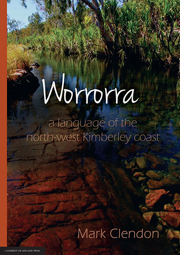Book contents
- Frontmatter
- Dedication
- Contents
- List of tables
- List of figures
- Abbreviations
- Acknowledgements
- Chapter One introduction
- Chapter Two segmental phonology
- Chapter Three morphophonology
- Chapter Four nouns and noun classes
- Chapter Five indicative mood and basic verbal morphology
- Chapter Six adjectives and inalienable nouns
- Chapter Seven pronouns, demonstratives, anaphors, deictics
- Chapter Eight optative, counterfactual and exercitive moods
- Chapter Nine number
- Chapter Ten adverbs and postpositional phrases
- Chapter Eleven complex predicates
- Chapter Twelve experiencer constructions
- Chapter Thirteen objects and possession
- Chapter Fourteen complement clauses
- Chapter Fifteen subjunctive verbs
- Chapter Sixteen middle voice
- Chapter Seventeen discourse cohesion
- Chapter Eighteen kinship terms
- Appendices
- References
Chapter Seventeen - discourse cohesion
Published online by Cambridge University Press: 05 October 2014
- Frontmatter
- Dedication
- Contents
- List of tables
- List of figures
- Abbreviations
- Acknowledgements
- Chapter One introduction
- Chapter Two segmental phonology
- Chapter Three morphophonology
- Chapter Four nouns and noun classes
- Chapter Five indicative mood and basic verbal morphology
- Chapter Six adjectives and inalienable nouns
- Chapter Seven pronouns, demonstratives, anaphors, deictics
- Chapter Eight optative, counterfactual and exercitive moods
- Chapter Nine number
- Chapter Ten adverbs and postpositional phrases
- Chapter Eleven complex predicates
- Chapter Twelve experiencer constructions
- Chapter Thirteen objects and possession
- Chapter Fourteen complement clauses
- Chapter Fifteen subjunctive verbs
- Chapter Sixteen middle voice
- Chapter Seventeen discourse cohesion
- Chapter Eighteen kinship terms
- Appendices
- References
Summary
Pronouns, especially the demonstratives reviewed in Chapter Seven, combine in a variety of ways with each other and with adverbs to produce an extensive pragmatic system with referential, deictic and indexical functions. We have already seen some of these pragmatic devices in the existential interrogatives in §7.4.3, the contrastive forms in §7.5.2 and §7.5.5, and the presentational forms in §7.5.4. In this chapter we will briefly observe an array of configurations that encode a number of important pragmatic categories, and which are in turn important in discourse cohesion.
As discussed in §5.3.1, subject and object grammatical relations are indexed on verbs as prefixes, by way of a set of tokens of the agreement-class of the nouns entering into those relations. This is quite a different state of affairs from signalling grammatical relations on the nouns themselves. Verb morphology merely codes the class of the noun in such-and-such a grammatical relation, and any instance of that class in the linguistic or extra-linguistic environment is a potential candidate for interpretation in that relation. The problem for this kind of grammar is that individuals rather than classes are usually required to be encoded in core grammatical relations. For instance eeja inja ‘man’ and warrala inja ‘boy’ are both members of the masculine singular agreement class, but the coding of that agreement class in a particular grammatical function fails to distinguish between the two nouns themselves.
- Type
- Chapter
- Information
- WorrorraALanguage of the North-West Kimberley Coast, pp. 420 - 459Publisher: The University of Adelaide PressPrint publication year: 2014



